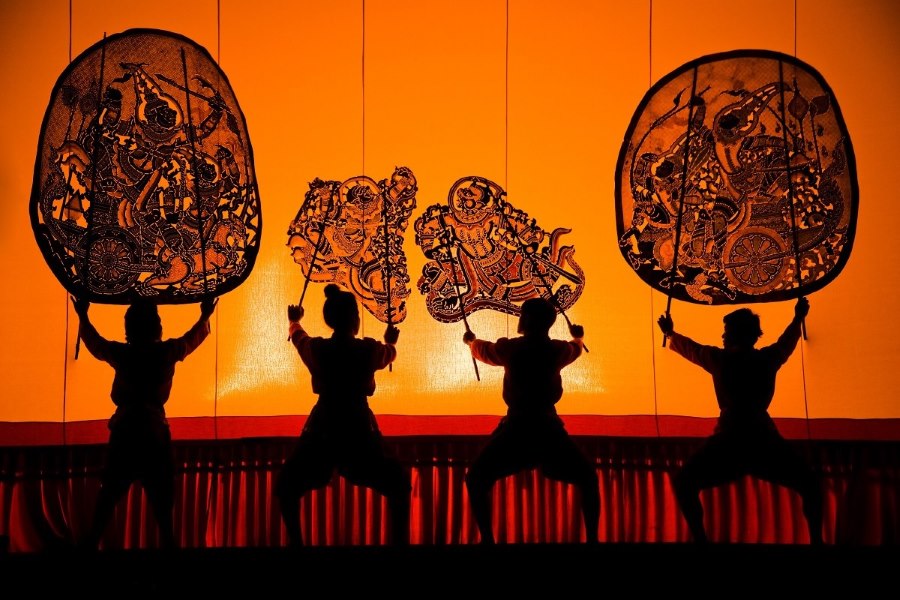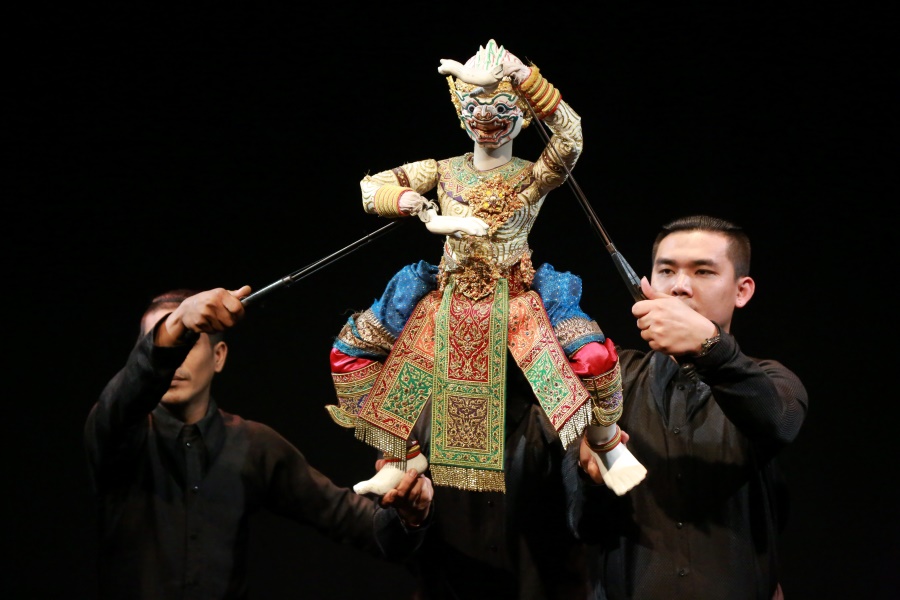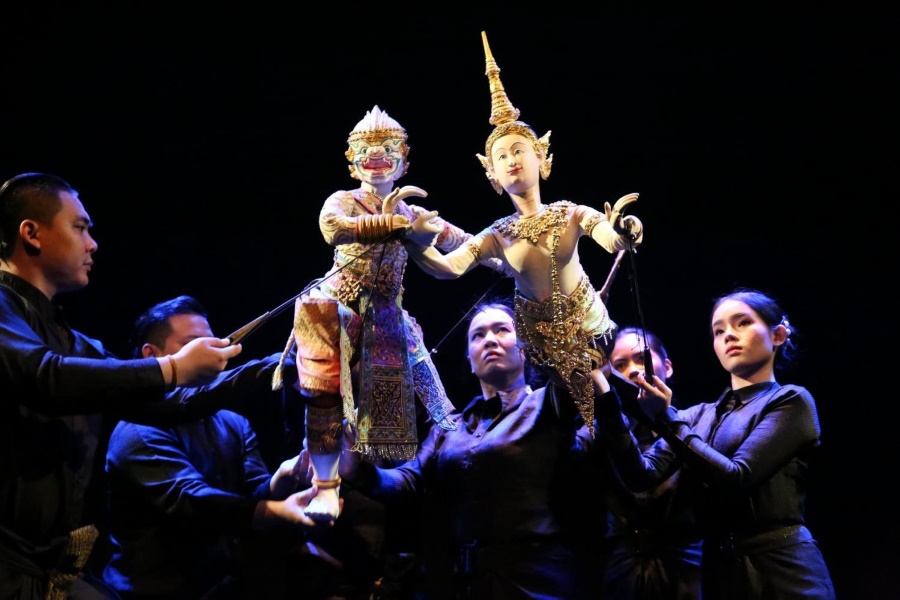
Thailand has boasted a rich domain of performing arts, with dancers and music being some of the most well-known. Thus, there is another equally enthralling performing art form: puppetry. It weaves together the meticulous artistry of puppet design, the mesmerizing dexterity of puppeteers, and the stories that give purposes to these inanimate figures and capture our imagination.
Puppetry is celebrated across the globe, including Thailand, where puppetry is greatly developed, expanded, and elevated to an unparallel art form and cultural pride.

Explore Thailand puppet theater as a fascinating traditional art form. (Source: Insights Guide)
In the period from 1351 to 1767, the locals had found the historical vestiges of puppetry in Thailand in different forms of records, which tells us that it is not merely a form of entertainment but an integral part of royal ceremonies and celebrations, from royal cremations to more commonplace events during the Rattanakosin period (1782–present) and the most popular story told through puppet plays in the Ramayana epic.
However, it is interesting to note that Thais perceive puppetry slightly differently from their Western counterparts do. According to the locals, the word "puppet," or hoon (หุ่น) in Thai, brings to mind the images of all types of puppets except shadow puppets, which they call “nang” (หนัง), meaning “hide or leather” after the very material used to craft them.

History of Thai puppetry. (Source: Remote Lands)
Read more: 7 Most Mesmerizing Shows You Can't Miss in Thailand
The Thai rod puppets, inspired by Chinese Hainanese counterparts, seamlessly fuse with iconic Thai styles, including khon-like costumes. Standing at a mere nine inches, each figure boasts a head and a cloak cascading from the shoulder, concealing the puppeteer’s hands as they deftly manipulate the bamboo rod.
These puppets exhibit humanlike movements, with articulated hands, mouth, and head. Notably, most rod puppeteers are women, taking on lead roles and providing character voices, save for clowns and male-specific roles.
A new type of theater puppet, similar to rod puppets but slightly larger and without lower limbs, was developed by Khru Piak (ครูเปี๊ยก), a veteran puppet troupe owner. Later, Khru Grae (ครูแกร), another luminary in the Thai puppetry, devised small theater puppets capable of leg movement, requiring three puppeteers for coordination. This demanded a more complex string system for precise articulation.
Upon Khru Grae’s passing, these puppets passed into the hands of Khru Sakorn Yangkheosod (ครูสาคร ยังเขียวสด), who revolutionized small theater puppetry by having puppeteers step forward from behind the curtain, allowing the audience to witness their synchronized performance.
This marked the birth of the renowned “Joe Louis Theater.”

Types of Thai puppetry. (Source: Chatrium Hotels & Residences)
The large royal puppet derives its name from the adjective “luang” (หลวง), which bears the dual connotations of both “royal” and “large.” This large puppet is one of a kind for two reasons.
Firstly, inside this one-meter-tall puppet lies the complicated network of twenty-two puppet strings, affording it a range of movements, down to the minute details of its eyeballs. Only one puppeteer commands each puppet.
Secondly, the control center at the base of the puppet requires the puppeteers, roles previously reserved for females only as they performed for the royal courts, to lift the puppet above their heads, never witnessed elsewhere in the world where puppeteers typically manipulate from above.
During King Rama V’s reign (1868-1910), a new type of puppet called “hoon wangna” was created by the viceroy, who resided at the Phraratchawang Bowon Sathanmongkhon Palace, colloquially referred to as the “Front Palace” or "Wangna," which is aptly named as it is situated in front of the Royal Palace, or “Wangluang,” where the king resided.
Standing at just one foot, the puppet is also referred to as “hoon lek,” meaning “small” in Thai. The royal small puppets comprise the Thai and the Chinese puppets. The Chinese ones depict characters from the Chinese saga Romance of the Three Kingdoms. They are hand puppets, painted like characters in xiqu, a traditional Chinese musical.
Thai puppets are full-bodied, adorned in splendid traditional attire, primarily portraying characters from the Ramakien, the Thai version of the Indian Ramayana epic.
The Thai puppetry has been evolving to embrace the modern world, ensuring its enduring relevance rather than fading into history. This transformation has given rise to contemporary puppet troupes, with Sema as one of the most outstanding.
Founded in 2004, the Sema Marionette Troupe is a group of local Thai artists who provide marionette and puppetry training to schools in Bangkok and beyond, with a notable achievement being the “Chor Chakram” youth marionette troupe in Samut Songkhram Province.

Types of Thai puppetry. (Source: Bangkok Post)
Their performances are infused with local charms, from folk songs to dialects and historical narratives, earning recognition as a prestigious Samut Songkhram art form. Sema Marionette Troupe’s dedication has also led to Thai marionettes being included in the World Record by the World Association of Puppeteers (WAP).
The “Puppetry Club” at Huachiew Chalermprakiet University has unveiled an inventive performance known as the “Thai Human Puppet” or “hoon khon” (“khon” means “human”.) In this fusion of ancient Thai arts, real people are guided by puppeteers to mimic puppet movements.
This contemporary Thai performance, celebrated for its outstanding performers, costumes, music, and adaptations from Thai literature, has earned international recognition. Additionally, it fosters a special rapport between performers and the audience.
Unlike other puppetry forms, shadow puppets captivate the audience through the interplay of light and shadow. These flat figures, crafted from cow and buffalo hides, project one-dimensional silhouettes onto a large white screen. They can be manipulated with or without strings. These are 3 main types of Thai shadow puppets.
Nang Yai performances mostly take place within temple grounds. Only a few places still perform this ancient artform, including Wat Khanon in Ratchaburi Province, Wat Sawang Arom in Singburi Province, Wat Ban Don in Rayong Province, and Wat Phlab Phla Chai in Phetchaburi Province.
Nang Yai (“yai” means “large”) employs large, intricately prepared hides, fastened to handles for puppeteers to perform behind and in front of the curtain. These hides are carved into seven types of scenes, each representing different action: Wai Khru ceremony, audience with the royals and gods, walking, flying, city and palace, fighting, and miscellaneous.

Types of Thai puppetry. (Source: Remote Lands)
Nang Talung is a traditional shadow play of Southern Thailand, also popular in South Asia and ASEAN regions like Malaysia, Indonesia, and Cambodia. The characters are divided into three groups: deities, nobles and protagonists, and commoners and jesters. The jesters, symbolizing the essence of Southern Thai culture, take center stage. They embody true southerners, speaking the local dialect infused with playful innuendos and witty food-related puns. These performances typically recount Thai folk tales, illustrating the struggle between giants and humans, which highlights how power dynamics can be overcome through wisdom and merit, ultimately leading to a triumph of good over evil.
Hailing from the Northeast of Thailand (Isaan), this performance seamlessly blends shadow puppetry with Mor Lam (หมอลำ), a traditional Isaan singing style. The linchpins of the show are the voice actors, requiring adept vocal skills, sharp wit, and linguistic prowess to enliven the tale and engage the audience.
It’s not unusual to find former Buddhist monks, renowned for their preaching, seamlessly transitioning into puppetry, adding a unique dimension to the art.
Crafted from delicate, semi-transparent calf skin, Pramotai puppets measure 1-2 feet and boast movable arms and mouths. While most characters are depicted in profile, the heroine stands facing the crowd directly.

Values of the Art. (Source: Art of Events Phuket)
The belief system surrounding Thai puppetry offers a unique glimpse into their connection with nature, particularly in the use of animal hides. Historically, only skins from animals with sacred histories, such as lightning-struck cows or stillborn calves, were chosen for carving revered shadow puppets. Additionally, the Wai Khru ceremony is a central ritual in Thai theater and art. This practice of paying tribute to teachers serves as an overture in various performances, including puppet shows.
The puppeteer must possess a deep understanding of this mechanical complexity and know when to press, push, and rotate to effectively engage with the puppets and convey nuanced emotions. In the mesmerizing choreography, the puppeteer synchronizes movements to the rhythm of the accompanying music, compelling the puppet to sway, bow, gesture, and dance.
Thai puppetry has undergone a transformative journey, originating in royal courts and evolving from an elite entertainment to a cultural emblem. Alongside this, shadow puppetry emerged in the south, spreading to central and northeastern regions, building a rich cultural heritage. Influences from China, India, and other places highlight Thailand’s cultural openness. Ultimately, puppetry serves as a unifying form of entertainment, transcending social boundaries.
Today, puppetry stands as a revered classical art in Thailand. It is crucial to keep in mind that for any art form to endure, it must continue to evolve and be appreciated through time. Given the opportunity, do not hesitate to step into the enchanting world of Thai puppet shows and let the charm of Thai artistry and talent captivate your senses with Asia King Travel.
Read more: 5 destinations for art lovers in Bangkok